
Five Siena students and their professor recently hit the road for the annual conference of the National Society of Black Physicists (NSBP) and got a great feel for life in academia.
The group traveled to Charlottesville, Virginia last week with Matt Bellis, Ph.D., associate professor of physics. Two students, Darryl Williams '23 and Keith Pritchett Jr. '25, presented their research in a judged poster session. Etienne Herron '25, Jalen McDonald '25 and Monica Robinson '25 also took part in what was their first academic conference of this scope. Team Siena sponsored an exhibitor’s table for the duration of the conference where they displayed a Siena-designed cloud chamber that allows physicists to “see” radioactive decays. (More on that below.)
“Everyone got a lot out of the experience,” said Bellis. “Our students had great interaction with students and faculty from other schools.”
Pritchett presented on the photometric analysis of nearby galaxies. He collaborated with John Moustakas, Ph.D., associate professor of physics and department chair, and Connor Stone, Ph.D. of Queen’s University in Quebec, who is the creator of the AutoProf code. Their research involved downloading and using the open source code, which fits multiple ellipses to a desired galaxy, while taking the average brightness of each ellipse per distance from the center of the galaxy. The code automatically filters out background light and creates a brightness profile that can be used to compare with other galaxies and older brightness profiles created by older codes.
“Our hopes are to use this code on the Siena Galaxy Atlas, which is our huge catalog of galaxies imaged at the Breyo Observatory, and test the code on galaxies that are not considered ‘nearby,’” Pritchett said. “Presenting at the conference was an amazing experience. I was able to connect with lots of professors at prestigious graduate institutions and view many interesting research projects that were conducted and are still ongoing that are impacting the field of physics and astrophysics.”
Pritchett, who also works with Moustakas on the Dark-Energy Spectroscopic Instrument (DESI), plans to attend grad school for astrophysics after Siena. He hopes one day to create an astrophysics company that will specialize in galaxy analyzations and exoplanet detection.
Williams has worked with Bellis and other Siena students since 2021 on improvements to a Siena-designed cloud chamber, a device that reveals vapor trails left by subatomic particles coming from radioactive decays and cosmic rays. At Siena, the cloud chambers are used in the classroom and for outreach projects.
The Siena designs use electronic devices called Peltier thermocoolers rather than dry ice to get to low temperatures. Williams and his fellow students modified designs they found online to make them more portable. Team Siena brought one of the devices to the conference to show at their exhibitor’s table to engage people in discussions about particle physics and the College’s internships with the U.S.-based collaborators on the Compact Muon Solenoid (CMS) general-purpose detector experiment at the Large Hadron Collider (LHC) in Geneva, Switzerland.
Williams’ specific research involved updating the turnkey cloud chamber particle detector. From various models made in the past he was able to design a new layout for the cloud chamber itself and rework how the components interact with each other. After updating the cloud chamber, he was able to test radioactive elements to visualize the particles they emit. His primary goal? To create a visualization to help students better comprehend topics about radioactive elements’ half-life and the particles they emit.
“I think what was most fun about the trip to the NSBP conference was to see how much of an impact my work could have on people in the physics community,” he said. “Physicists saw my research and thought of how it could be implemented at lower levels of education to intrigue more students to become physicists.”
After Williams graduates in May with his bachelor’s in applied physics and engineering, he will go on to grad school at Clarkson University for a master’s in electrical engineering.
The NSBP “seeks to develop and support efforts to increase opportunities for African Americans in physics and to increase their numbers and visibility of their scientific work,” as well as develop activities and programs to highlight the scientific contributions made by African American physicists provide for the international community.
Bellis attended the conference on behalf of the U.S. contingent of the particle physics collaboration with the CMS at the LHC in Switzerland. They are ramping up for the second year of dedicated summer internships aimed at Black and other underrepresented minority students.
The Siena conference travel was supported by CURCA and the Physics Department.

